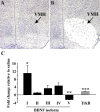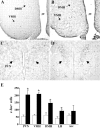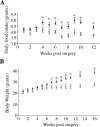Selective deletion of Bdnf in the ventromedial and dorsomedial hypothalamus of adult mice results in hyperphagic behavior and obesity
- PMID: 18160634
- PMCID: PMC6673437
- DOI: 10.1523/JNEUROSCI.3308-07.2007
Selective deletion of Bdnf in the ventromedial and dorsomedial hypothalamus of adult mice results in hyperphagic behavior and obesity
Abstract
Brain-derived neurotrophic factor (BDNF) and its receptor TrkB are expressed in several hypothalamic and hindbrain nuclei involved in regulating energy homeostasis, developmentally and in the adult animal. Their depletion during the fetal or early postnatal periods when developmental processes are still ongoing elicits hyperphagic behavior and obesity in mice. Whether BDNF is a chief element in appetite control in the mature brain remains controversial. The required sources of this neurotrophin are also unknown. We show that glucose administration rapidly induced BDNF mRNA expression, mediated by Bdnf promoter 1, and TrkB transcription in the ventromedial hypothalamus (VMH) of adult mice, consistent with a role of this pathway in satiety. Using viral-mediated selective knock-down of BDNF in the VMH and dorsomedial hypothalamus (DMH) of adult mice, we were able to elucidate the physiological relevance of BDNF in energy balance regulation. Site-specific mutants exhibited hyperphagic behavior and obesity but normal energy expenditure. Furthermore, intracerebroventricular administration of BDNF triggered an immediate neuronal response in multiple hypothalamic nuclei in wild-type mice, suggesting that its anorexigenic actions involve short-term mechanisms. Locomotor, aggressive, and depressive-like behaviors, all of which are associated with neural circuits involving the VMH, were not altered in VMH/DMH-specific BDNF mutants. These findings demonstrate that BDNF is an integral component of central mechanisms mediating satiety in the adult mouse and, moreover, that its synthesis in the VMH and/or DMH is required for the suppression of appetite.
Figures








References
-
- Adamec RE. Partial kindling of the ventral hippocampus: identification of changes in limbic physiology which accompany changes in feline aggression and defense. Physiol Behav. 1991;49:443–453. - PubMed
-
- Ahima RS, Kelly J, Elmquist JK, Flier JS. Distinct physiologic and neuronal responses to decreased leptin and mild hyperleptinemia. Endocrinology. 1999;140:4923–4931. - PubMed
-
- Bariohay B, Lebrun B, Moyse E, Jean A. Brain-derived neurotrophic factor plays a role as an anorexigenic factor in the dorsal vagal complex. Endocrinology. 2005;146:5612–5620. - PubMed
-
- Berton O, McClung C, Dileone RJ, Krishnan V, Renthal W, Russo SJ, Graham D, Tsankova NM, Bolanos C, Rios M, Monteggia LM, Self DW, Nestler EJ. Essential role of BDNF in the mesolimbic dopamine pathway in social defeat stress. Science. 2006;311:864–868. - PubMed
Publication types
MeSH terms
Substances
Grants and funding
LinkOut - more resources
Full Text Sources
Medical
